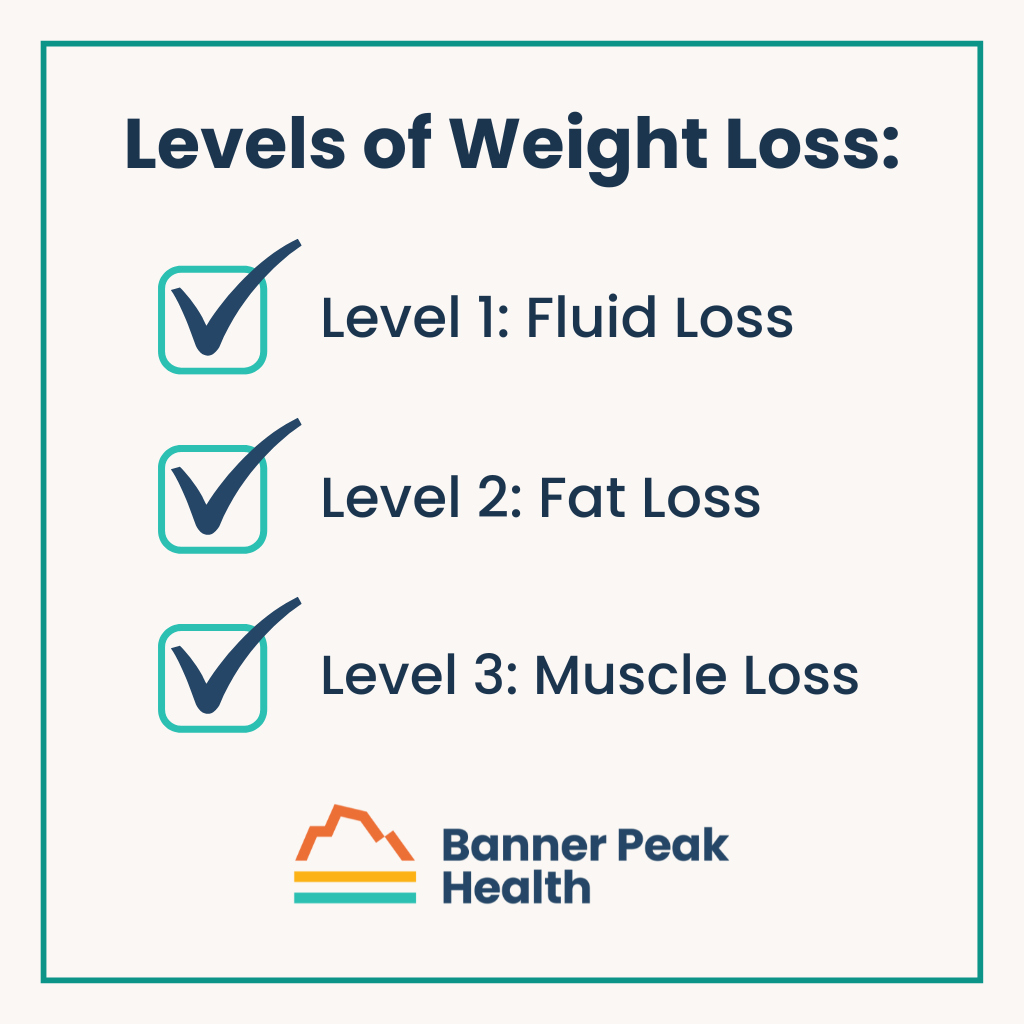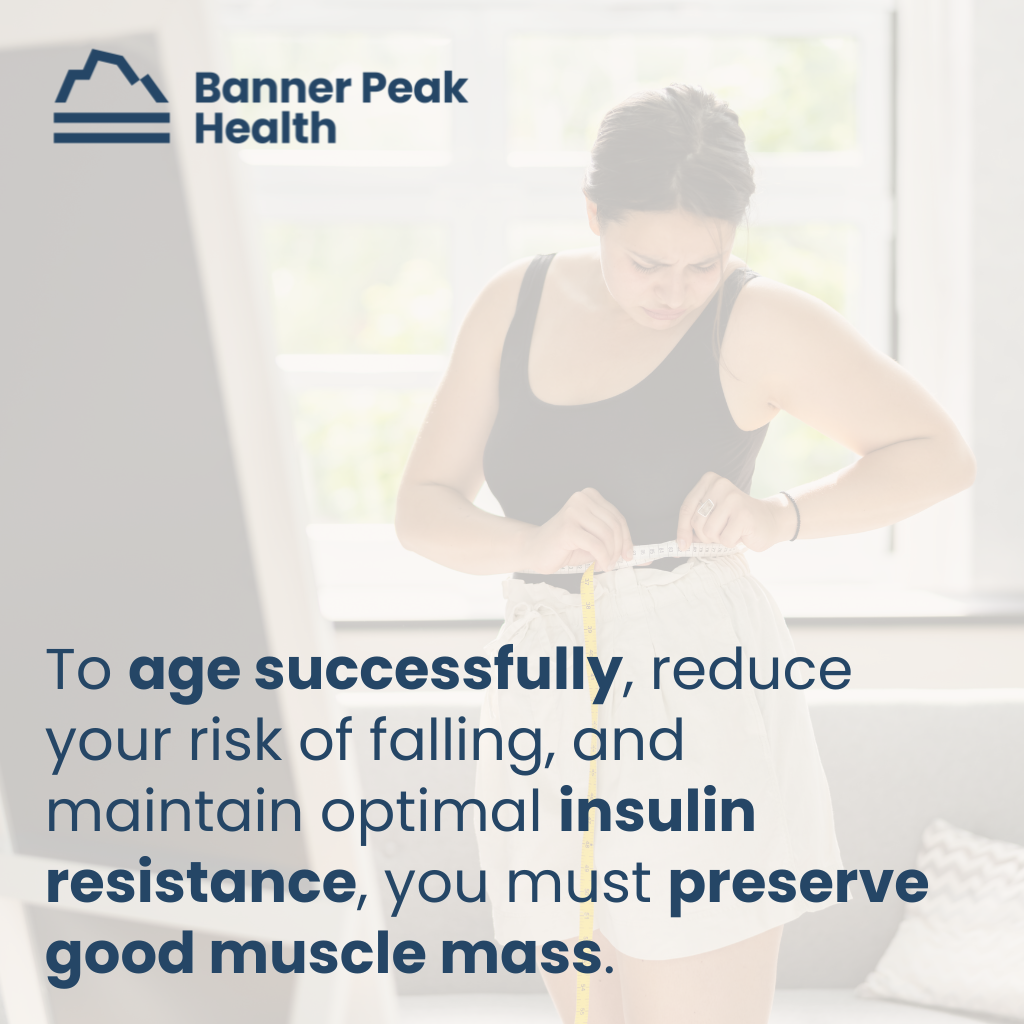We’ve used scales to measure mass for thousands of years, but humans aren’t composed of homogeneous densities like gold or wheat. We have various components, including three that comprise most of our mass: fluids, fat, and muscle.
Today, our technology, including DEXA and bioelectrical impedance analysis (InBody), can break down a person’s weight into those three components.
Despite the advances in weight measurement technology, we still face the question, “How long does it take to see weight loss?” As with so many other questions in healthcare, the answer is, “It depends.”
Level 1: Fluid Loss
The largest percentage of our body mass — 50% to 60% — is water containing minerals and electrolytes.
Sodium is the mineral we have in the greatest quantity. Our bodies closely regulate sodium concentration, as our cells can only survive slight variations.
The recommended daily amount of ingested sodium chloride is less than 2,300 milligrams (mg). However, the average American diet contains over 3,400 mg of sodium chloride daily. That’s 70% more sodium than is helpful for the human body.
How does this happen?
Processed foods contain a lot of added sodium, whether in a can, a box, frozen, or otherwise prepared. Foods processed in any way have too much salt.
Your body will always seek equilibrium — a balance between excess salt and water to flush it out. Increased sodium intake leads to increased excretion by the kidneys, assuming your body is healthy. There are disease states, such as heart and kidney diseases, that prevent the body from excreting excess salt, leading to progressive swelling and edema.
In these cases, the body can’t maintain equilibrium, and water and salt continue to increase in volume within the body, which leads to an increased risk of poor health outcomes.
Let’s return to the question, “How long does it take to see weight loss?” This first level pertains to rapid weight loss, usually during the first week of a diet. Here’s why.
During the first few days of a diet, you probably fast and eat less, or at least eat less processed food (less salt). Your body has an easier time finding equilibrium and purging excess fluid. So, the first few days, when you lose a couple of pounds (lbs) a day, that weight loss results from losing fluid — not losing fat.
Level 2: Fat Loss
After the initial fluid loss during the first week or so, your body shifts into a different type of weight loss.
Here’s where we’ll use some math to explain the time frame for how fat loss works and how it doesn’t. Don’t worry; it’s not as much about counting calories as you think.
We’ll say a pound of fat represents about 3,500 kilocalories of energy. To lose a pound of fat, you’ll need to burn an additional 3,500 calories daily, consume 3,500 fewer calories daily, or some combination. This is why the weight loss you experience in the first week isn’t fat loss.
For example, to lose two pounds of fat (spend 7,000 calories) in one day, you’d have to not only walk for 14 hours straight (spend 500 calories per hour) but also not eat anything at all. The math doesn’t add up. Thus, those two pounds had to be fluid loss.
Here’s an example of how to lose fat sustainably:
Sustainable Fat Loss
Gradual weight loss is much more reasonable and healthier. Think 0.5–2 pounds per week. It may not seem like enough, but it can add up over time (e.g., a year).
The caloric deficit translates to between 1,750 and 7,000 calories per week or 250 to 1,000 calories daily. For example, can you give up a couple of cookies every day or walk a bit longer?
Those small changes mean big results over 52 weeks! Consuming two hundred fewer calories daily and burning 300 calories daily by walking creates a 3,500-calorie deficit per week multiplied by 52 weeks, which equals 52 pounds! You can lose this by making those two small changes in your daily routine.
How to Lose It Faster
But we want results now, right? Well, here are the problems with weight loss:
- We can’t control where our weight loss happens in our bodies. Unfortunately, we can’t point to our stubborn belly fat and impose our will upon it to disappear first.
- We can’t control the fat loss ratio. Muscles metabolize just as easily as fat, but it’s not healthy for us to lose muscle mass, so we must be careful about how we lose weight.
(Undesirable) Level 3: Muscle Loss
Muscles help determine our basal metabolic rate, which is how many calories we burn daily by simply being alive — heart beating, lungs breathing, blood circulating, etc. They also help us maintain a caloric balance.
When we lose weight, we lower our basal metabolic rate by losing muscle mass. However, this makes it harder to continue making weight loss progress.
If you lose enough muscle, your endocrine system thinks you’re starving. It puts your body into survival mode, making it harder for you to lose weight.
We want to avoid reducing our basal metabolic rate because 90% of our glucose is distributed in muscle. Maintaining muscle mass is essential for good glucose homeostasis and reducing insulin resistance.
For these reasons, when we guide someone through a diet, we focus on what’s happening to their muscle mass.
As we age, our hormones, lifestyles, and protein intake make it more challenging to maintain muscle mass. Normal muscle mass loss carries the risk of sarcopenia.
To age successfully, reduce your risk of falling, and maintain optimal insulin resistance, preserve good muscle mass.
The New Era of Rapid Weight Loss and Beyond: Our Approach
If you spend down your muscle mass through dieting, it makes it that much harder to regain it as you age. In traditional calorie-restricted diets, people tend to lose 75% of that mass as fat and 25% as muscle.
With new technology such as GLP-1 medications (e.g., Wegovy, Ozempic, Mounjaro), people often lose weight more rapidly than 0.5 to 2 pounds per week. We’re also seeing a change in the distribution of weight loss. It’s not uncommon for people on GLP-1s to lose 60% fat and 40% muscle mass, which is potentially dangerous.
Firstly, we measure your weight every time we see you — not just annually. If you’re taking a GLP-1 medication, we must closely monitor your fat, fluid, and muscle mass.
Also, in conjunction with our patients’ calorie restriction, we ask them to eat more protein. It can be challenging because we ask them to eat less overall but add more protein to their restricted diet, but it’s essential.
When necessary, we also have our patients work with nutritionists. We’re laser-focused on this.
Food is our fuel. Calories don’t just make you fat. They allow you to move. You need enough fuel to stimulate movement to maintain muscle mass.
Along with nutrition specialists, we refer patients to fitness instructors to help with strength training and customized programs to preserve muscle mass. Exercise is a must for a long, quality healthspan.
Today’s Takeaways: How Long Does It Take to See Weight Loss?
Understanding our bodies’ three main components (fluids, fat, and muscle):
- Helps us appreciate the risks and benefits of losing weight at different tempos.
- Explains why people lose weight rapidly through fluid loss as they reduce their sodium intake.
- Provides insights into how fat loss differs and is best maintained with a more gradual approach.
- Demonstrates how crucial muscle mass is to our overall health and how easy it is to lose if we’re not careful during our weight loss journeys.
Focus on protein intake, strength training, and healthy weight loss monitoring to answer “how long does it take to see weight loss” for yourself. And if you need a helping hand, we’re a phone call away.

Barry Rotman, MD
For over 30 years in medicine, Dr. Rotman has dedicated himself to excellence. With patients’ health as his top priority, he opened his own concierge medical practice in 2007 to practice medicine in a way that lets him truly serve their best interests.





